Chaco Canyon: A Celestial Vision Preserved in Stone
At the center of the ancient world are the people surrounded by the passing of time and space. The rising and setting of celestial bodies along various points on the horizon shaped the belief systems of our early ancestors. As archaeologists uncover more buildings at ancient sites, the movements of the celestial bodies are becoming more apparent in the architectural design of ancient civilizations. The stone ruins of Chaco Culture National Historical Park are a purposeful arrangement of 15 major buildings aligned to the heavens. The precision of alignment required generations of astronomical observation and centuries of skillful construction. In 1150 C.E., after only 250 years of occupation, the site was abandoned.
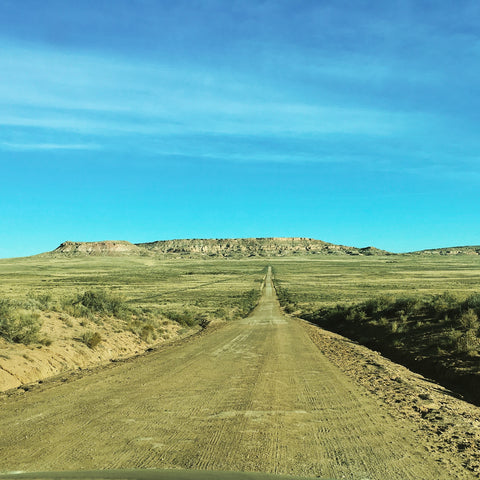
Chaco Canyon inhabits nearly 34,000 acres in northwestern New Mexico's high desert. To reach the canyon requires 20 miles along a rough dirt road. Eager to visit I convinced my mother to tour the ruins in early autumn when the weather conditions were ideal. After exiting the busy Interstate 40, we found ourselves rather quickly traveling down a desolate desert highway. Nearly an hour later, a modest sign points us in the right direction. Slowing to a near halt, we gaze upon an endless barren road stretching to the horizon. Hesitant, we looked around with only one option.
The first few miles my mother drove cautiously until we realized that it would take more than an hour to reach the park entrance. We increased our speed through the dry dusty plains and to our surprise the rutted road softened. Soon after, iconic Fajada Butte appeared around the final bend.

Fajada Butte rises 135 meters or 442 feet from the canyon floor. Petroglyphs, pottery, and cliff dwellings have been found, as well as, a constructed long ramp leading to the upper regions of the butte.
Humans have inhabited the San Juan Basin surrounding the canyon for over 10,000 years. Between 850 - 1150 C.E., Chaco Canyon was a major center of culture for the Ancient Pueblo people who constructed the elaborate multi-storied "Great House" structures. Chacoans utilized the movements of the rising and setting sun and moon in the placement and design of the structures. Due to long winters, hot, dry summers and the remoteness, the sites at Chaco Canyon are believed by archaeologists to be for periodic ceremonial use rather than habitation. Likewise, today there are no lodgings only camping for the few intrepid souls who journey the unpaved roads to reach the canyon.
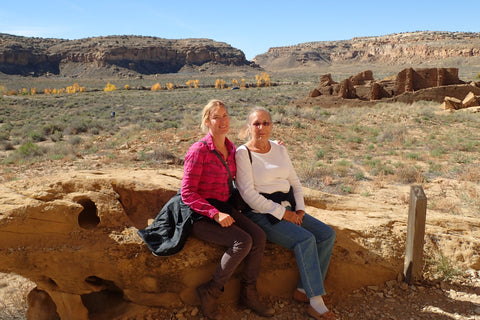
My mother and I hiking the ruins of Chetro Ketl.
We arrive in time for the Park Ranger's tour of Chetro Ketl, the second largest stone structure in the Southwest. The original construction was a single story large room. By the 12th century, nearly one hundred years later, intricate buildings covered 3 acres with over 500 rooms and 3 stories high, including a subterranean Kiva. In modern Puebloan cultures, kivas are used for religious worship, dance, prayer, and other public activities. Ceremonial items like beads, as well as, pictographs were found during excavation. Our enthusiastic guide, Jackson Lincoln remarks, "It's kinda ironic the artifacts were uncovered to be reburied in boxes." According to the National Parks' website more than a million Chacoan artifacts have been excavated and are stored in museums.
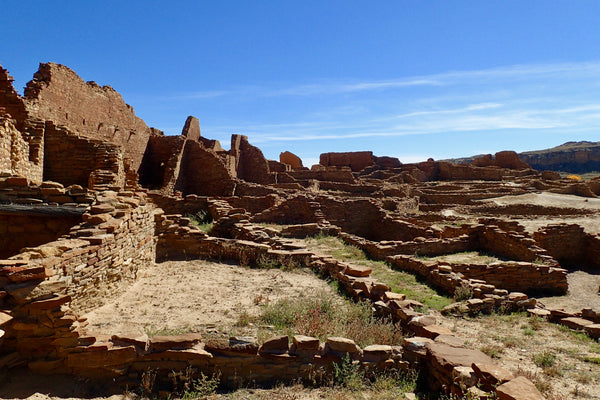
The Great House of Chetro Ketl.
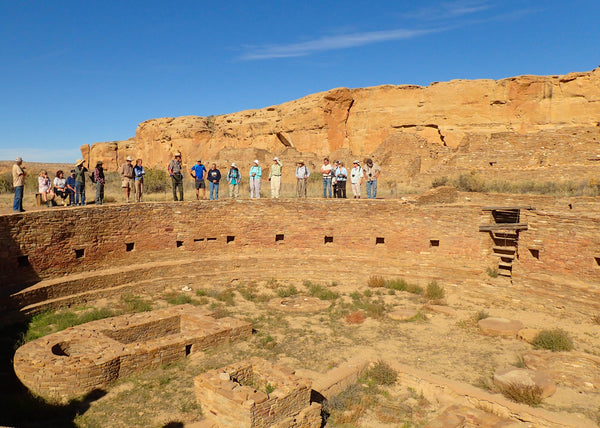
Ceremonial Kiva at Chetro Ketl
Inside the Chetro Ketl Kiva is 29 niches or recesses believed to correlate with the phases of the moon. Studies of the archaeoastronomy of Chaco Canyon sites by the Solstice Project reveal the north and south walls of Chetro Kelt in perfect alignment with an 18-year lunar cycle. During this cycle, the moon will rise and set along its most southerly point on the horizon known as a minimum moon and roughly 9 years later will reach its most northerly point on the horizon known as a maximum moon. A full cycle is 18.6 years and referred to as a Lunar Standstill. The south and north walls of Chetro Ketl and other sites in the canyon align exactly with the transit of the minimum and maximum moons. Most impressive is that the moon's setting points on the horizon are not visible due to the canyon walls.
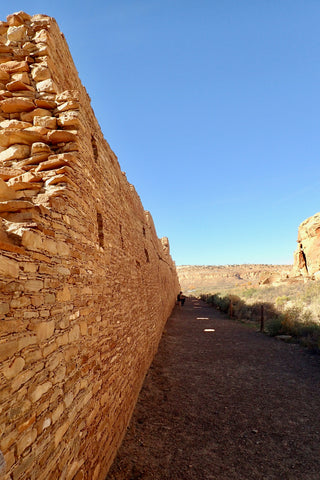
The northern wall of Chetro Ketl aligns with the maximum moon of the 18.6-year lunar cycle. March 7th, 2025 the moon will reach its next maximum.
Chaco Canyon was at the center of an ancient world for over 100 years. At its height, the scale of the main buildings inside the canyon would have rivaled the grandeur of the Roman Colosseum. Over 12 generations of people walked 200 miles of well-engineered roads to reach Chaco Canyon. The specific purpose of this magnificent city remains a mystery. However, archeologists recognize the Chacoan complex as a sublime colossal timepiece important to the ancient people of the Southwest. Today, many Pueblo people consider the area to be sacred and a part of their history.
The isolation of the area has won Chaco Canyon the designation of an International Dark Sky Park. Later that evening, my mother and I pull to the side of the road to view the night sky. Above our heads was the brilliant spiraling arm of the Milky Way galaxy. Nearly 80 percent of Americans and a third of the world can no longer see our galaxy at night. To the ancients, our civilization would be lost.

Milky Way by Clarisse Meyer
*** Chaco Canyon is under attack from Oil & Gas leases for fracking. Please visit the WildEarthGuardians.org to find out how you can help.

2 comments
Samaria, yes Chaco is an amazing heritage site. There is so much to see that several more trips are needed. Maybe soon.
the chaco canyon is very cool lots and lots of information about the chaco canyon